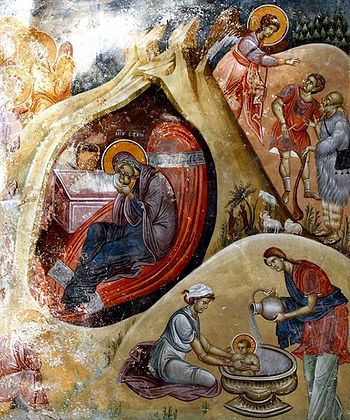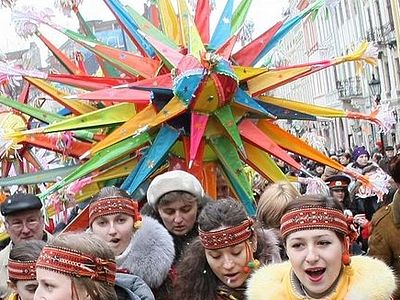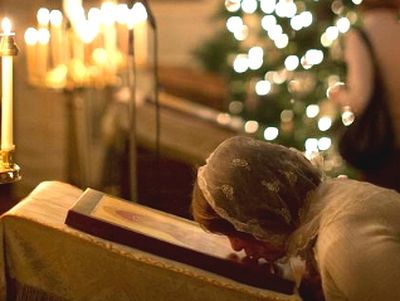One of the many wonderful aspects of the Orthodox-Catholic celebration of the birth of Christ is the traditional season of "Christmastide" or the "12 Days of Christmas." This is one of those rare periods in the life of the Church where all fasting is suspended and where the fulness of Christ's Incarnation is on display in the following days.
Thankfully, people have come to understand more and more that the feast of Christmas was not established as a replacement of a "pagan holiday" (as is proposed in popular discussion), but is rather an intentional celebration of the unique birth of our Lord according to the flesh. The Annunciation (celebrated March 25/April 7) was celebrated as a feast much earlier in the life of the Church, and the tradition of Christmas was originally established (in the west) that Christ was born nine months later on December 25/January 7.
The day of the Annunciation (Christ's conception in the womb of the Virgin Mary by the Holy Spirit) was first celebrated on April 6 in the eastern churches, and the totality of Christ's Incarnation (birth, circumcision, and baptism) was also celebrated nine months later on January 6. Once St John Chrysostom brought the celebration of Christmas (from Rome) to the Church of Antioch, it soon spread throughout the rest of the eastern churches. The feast of Theophany was kept as the end of this 12-day "Christmas season."
This period of Christmastide is fast free, but not because we are fulfilling the desires of our flesh and embracing gluttony. Instead, it is fast free because we are celebrating the purification and redemption of creation that is wrought by Christ's Incarnation (whereby all foods are "holy" and acceptable for Christians). We will traditionally give gifts to one another, imitating both the magi of the east (who brought gifts to the Savior) and the Theotokos who offered Christ as a gift for the life of the world.
On the day after Christmas (Dec. 26/Jan. 8), a synaxis—a coming together or gathering—of all the feasts and the whole life of the Theotokos is celebrated; first and foremost because by giving birth to Christ, she became an instrument of our salvation through his Incarnation. Mary served as the prototype of a living "temple of the Holy Spirit," and those of the Church after her—both individually and collectively—imitate her in this regard.
This celebration of Mary is followed by the commemoration (Dec. 27/Jan. 9) of the first Martyr of the Church ("Protomartyr") after Christ's ascension: the deacon Stephen. The Kontakion of this feast tells the story beautifully, in that: "Yesterday the Master arrived in the flesh; today the servant departs from the flesh. Yesterday he who reigns was born; today the servant dies for him by stoning." As a holy martyr, Stephen was a true "witness" (which comes from the Greek word for "martyr") of the importance of Christ's Incarnation.
On the 29th of December, we remember the horrific slaying of approximately 14,000 infants at the behest of Herod, whose jealousy of the coming Messiah was manifested in this slaughter (and including his own child). This day implores us to emphatically not be like Herod in our own attempted destruction of Christ in our lives. A life in Christ is a life of martyrdom (as shown by Stephen) and submission (as shown by Mary); in other words, it is a life of humility. By fearing this humility, Herod "lamented that his power would soon be destroyed" (Kontakion) and sought to destroy Christ instead.
The Sunday after Nativity serves as a commemoration of many of Christ's relatives "according to the flesh." These "ancestors of God" serve as the first examples of how we are to both worship and imitate our newborn Savior: Joseph the Betrothed, the elderly man entrusted with the care of the virgin Mary, believed in the Lord through an angel and overcame the temptations of Satan. With the magi of the east, he too bowed down and worshipped the newborn King. David, the king and psalmist, serves as an Icon of true repentance and provided the people of God with an abundance of prayers and songs for both our own acts of repentance and the continual praise of Christ. These psalms, of course, also serve as beautiful reminders of Christ's birth, life, death, and resurrection. And finally, James, the "brother of God" (being either the son or nephew of Joseph), was the first leader of the Church of Jerusalem: "As the Lord's disciple, O righteous One, you received the Gospel; as Martyr, you have unwavering courage; as the Lord's brother, you have forthrightness; as Hierarch, intercession" (Apolytikion).
The circumcision of Christ is then celebrated (Jan. 1), not only as a beginning to his fulfillment of the Law, and the transition of God's revelation to mankind (after the fall) from "shadow" (Heb. 8:5) to reality, but also as the occasion of the naming of the child as Jesus (which means "Savior"). We too receive a new name through the Church in the mystery of Baptism—the Christian fulfillment of circumcision—after the example of Christ. Through this, our whole life is dedicated to Christ through the intercession of saints (Heb. 12:1; Rev. 8:4) and the protection of angels (St. Matt. 18:10; Jude 1:9).
On January 3rd, the holy prophet Malachi, the last of the so-called "minor prophets," is commemorated. Malachi prophesied in the middle of the 5th century before Christ (B.C.), within the Persian court of Artaxerxes, that the "Sun of Righteousness" would soon enter the world, with "healing on his wings" (Mal. 4:2).
On the following day, the original "seventy apostles" of Christ are commemorated (cf. Luke 10:1-16), who were first sent into the world with the Gospel message. These men and women remind us that, as we have received the infant Christ in his Nativity, it is now our turn to share him (imitating Mary) with the rest of the world. We must take this message of an infant King of Kings, along with the good news of his life, death and resurrection, into all creation (St. Mark 16:15), just as these first apostles and disciples of Christ did.
And finally, we conclude the Christmastide with the Great Feast of the Theophany (sometimes called Epiphany) on January 6th. In the baptism of Christ, by the hands of the servant John (the Forerunner), the Divinity of Christ and the full mystery of the all-Holy Trinity are revealed. "Theophany" means "divine manifestation," and we are reminded continually, in the life of the Church and her worship, of this manifestation of Christ as the "God-Man," along with the unique and incomprehensible mystery of the Trinity. In fact, the abundance of our rituals regarding the sanctification of this created order—including within our churches—is a reflection of this Incarnational mystery: "Our reverence, our veneration is never related to 'matter,' but always to that which it reveals, of which it is an epiphany, i.e., a manifestation and presence ... consecration in the Church is not a creation of 'sacred objects' ... but their referral to their original and at the same time ultimate meaning" (Schmemann, The Eucharist, p. 61). Along these lines, we hear in the Kontakion: "You appeared to the world today, and Your light, O Lord, has left its mark upon us." We must share this light with the "darkness" of the world, as "little Christs" (i.e., "Christians"), cooperating with the Spirit of God in the redemption of creation through Christ Jesus. Christ, who entered this world with the humility of a child born to die—being wrapped in the swaddling burial cloths of death—who by his own death defeated death itself.
Ultimately, then, the meaning of both the Nativity of Christ (i.e., Christmas), and the entirety of the Christmastide, is the receiving and giving of Christ, who is truly the Gift and the Giver, the Receiver and the Received.
In this Eucharistic Mystery, we are called to imitate Christ's Mother in our sharing of Christ with the world; to imitate Stephen in our being a true "witness" (i.e., "martyr") for Christ, to this world that would seek to imitate Herod; to imitate a life of true repentance like David and a life of simple, prayerful obedience like the elderly Joseph; to imitate the Theophany of Christ with our own manifestation of the light of Christ in the darkness of this world; and to be a true reflection of the all-Holy Trinity through our unity, communion, and mutual love within the Church.
We receive the uncreated light of the Christ-child on the day of Nativity, and are made ready to share that light with the whole world by the end of the Christmas season. May we all come to fervently appropriate the commemorations and feasts of this wonderful time of the year; not only for our own sakes, but especially for the life of the world.




